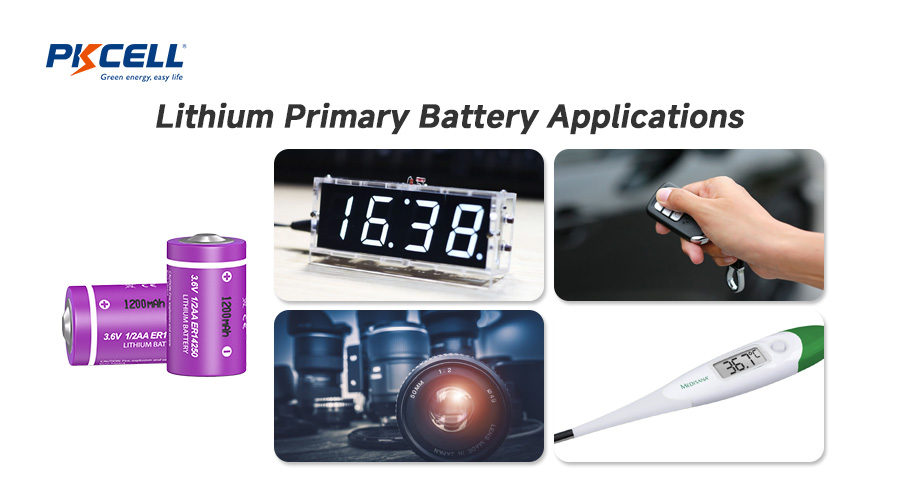Points clés
- Connaître l'état de charge (SoC) de vos batteries primaires peut améliorer leur fonctionnement et leur durée de vie. Cela garantit une utilisation optimale de toute l'énergie stockée.
- Certaines méthodes traditionnelles de vérification du SoC, telles que la tension en circuit ouvert et le comptage de charges, posent problème. Par conséquent, de nombreux utilisateurs recherchent désormais des méthodes plus performantes et plus modernes.
- De nouvelles méthodes comme la spectroscopie d’impédance électrochimique (EIS) et l’utilisation de l’apprentissage automatique donnent désormais des résultats plus précis pour le SoC.
- Ces nouvelles méthodes améliorent la sécurité et le fonctionnement des batteries primaires au lithium. Elles ouvrent également de nouvelles perspectives d'utilisation concrète de ces batteries.
Pourquoi l'estimation du SoC est importante
Les batteries au lithium dans la vie quotidienne et les applications critiques
Les piles au lithium sont présentes presque partout. Elles alimentent les horloges, les appareils photo et les télécommandes de voiture. Leur grande longévité est due à leur densité énergétique élevée, qui leur permet de stocker davantage d'énergie simultanément. Elles sont également très fiables, ce qui les rend idéales pour les appareils à faible consommation comme les montres et les thermomètres.
Dans certains domaines nécessitant une utilisation plus poussée des batteries, les batteries primaires jouent un rôle essentiel. Il s'agit notamment des outils utilisés en recherche océanographique et des dispositifs médicaux comme les stimulateurs cardiaques et les défibrillateurs. Ces batteries sont robustes, même dans les situations les plus difficiles.
Dans les utilisations essentielles, des batteries adaptées peuvent garantir la sécurité des utilisateurs. Une défaillance de batterie peut être dangereuse ou empêcher le fonctionnement d'un appareil important. Il est donc essentiel de connaître précisément l'état de charge (SoC) de la batterie. Cela permet de garantir la fiabilité de l'appareil.
SoC : la clé de la fiabilité et de l'efficacité
L'estimation de l'état de charge est essentielle pour garantir la sécurité et le bon fonctionnement des batteries au lithium. Elle permet de vérifier la charge restante de la batterie et de garantir son bon fonctionnement, même dans les situations les plus difficiles.
Les mesures du SoC permettent de gérer la consommation d'énergie de l'appareil. Cela permet un fonctionnement plus long et plus performant. Connaître le bon état de charge permet d'éviter les temps d'arrêt et facilite la planification de nombreuses utilisations, comme pour les appareils électroniques classiques ou les instruments médicaux importants.
Lorsque vous savez que vos batteries au lithium fonctionneront toujours de la même manière, le SoC vous aide à maintenir la stabilité. Cela ouvre également la voie à de nouvelles expériences, comme les systèmes de batteries intelligents.
Problèmes avec les méthodes SoC traditionnelles
Les anciennes méthodes de vérification de l'état de charge (SoC) ne répondent souvent pas aux attentes, notamment pour les batteries au lithium. Certaines méthodes, comme la tension à vide (OCV) et le comptage de Coulombs, ont fait leurs preuves par le passé. Cependant, elles ne donnent pas de bons résultats en conditions réelles.
Les problèmes s'aggravent encore avec l'utilisation de systèmes à haute densité énergétique, comme les batteries primaires au lithium. Cela nuit à la gestion de l'énergie et réduit la fiabilité. Pour répondre aux besoins croissants en énergie dans de nombreux domaines, il est crucial de développer de nouvelles méthodes de SoC.
Limitations de la tension en circuit ouvert (OCV)
La tension à vide, ou OCV, peut aider à indiquer l'état de charge des batteries primaires au lithium. Cependant, elle n'est pas toujours parfaite. L'OCV nécessite une stabilité, difficile à maintenir lorsque la batterie est utilisée. Les variations de charge et de température peuvent modifier sa lecture. L'OCV ne reflète pas non plus ce qui se passe à l'intérieur de la batterie, comme sa résistance interne ou les actions électrochimiques dans les cellules au chlorure de thionyle de lithium. Par conséquent, l'OCV peut ne pas être toujours adaptée à une utilisation réelle. Ainsi, même si l'OCV peut fournir des informations utiles, il ne faut pas l'utiliser seule pour évaluer le fonctionnement d'une batterie primaire au lithium.
Inconvénients du comptage de Coulomb
Le comptage de Coulomb est une méthode bien connue pour déterminer l'état de charge (SoC) en additionnant le courant entrant et sortant d'une batterie au fil du temps. Le principe est simple, mais cette méthode est souvent inefficace avec les batteries primaires au lithium.
Cette méthode ne prend pas en compte l'autodécharge. C'est un problème majeur, car l'autodécharge est fréquente dans les batteries au lithium primaires. Au fil du temps, les erreurs de mesure s'accumulent. Le comptage de Coulombs est donc un mauvais choix pour des appareils comme les instruments océaniques ou les stimulateurs cardiaques, pour lesquels des résultats fiables sont nécessaires sur une longue période.
D'autres facteurs, comme la température et l'utilisation des batteries, influencent également les valeurs obtenues. La méthode devient encore moins fiable lorsqu'il s'agit de prédire la densité énergétique des batteries au lithium. À mesure que les résultats s'améliorent, se fier uniquement au comptage de Coulombs ne permet pas de prendre en compte des aspects importants de l'estimation de l'état de charge.
Innovations récentes dans les méthodes d'estimation du SoC
Les avancées dans la vérification de l'état de charge (SoC) font désormais appel à de nouveaux outils comme la spectroscopie d'impédance électrochimique (SIE) et l'apprentissage automatique. Ces méthodes permettent d'obtenir des résultats plus précis et plus flexibles avec les batteries au lithium. Elles fonctionnent parfaitement avec des batteries puissantes, comme celles utilisant du chlorure de thionyle de lithium.
Spectroscopie d'impédance électrochimique (EIS)
La spectroscopie d'impédance électrochimique (SIE) est une méthode essentielle pour vérifier le bon fonctionnement et l'état de santé des batteries primaires au lithium. Cette technique mesure l'impédance d'une batterie à différentes fréquences. Elle permet ainsi de visualiser les processus électrochimiques internes. La SIE est très utile pour l'analyse des batteries au lithium-chlorure de thionyle. Elle permet d'identifier les variations de la résistance au transfert de charge et le mouvement des ions à l'intérieur de la batterie. Une étude approfondie des données de la SIE permet de trouver des solutions pour augmenter la densité énergétique et prolonger la durée de vie de ces batteries primaires au lithium. Cela permet d'optimiser les performances des batteries au lithium, comme celles des batteries au lithium-chlorure de thionyle.cellules au chlorure de lithium thionyle.
Approches basées sur les données et l'apprentissage automatique
L'utilisation de l'apprentissage automatique dans l'estimation des SoC offre de nouvelles possibilités pour des systèmes plus flexibles et plus détaillés. Ces méthodes peuvent analyser de nombreuses données provenant de batteries au lithium, ce qui les aide à identifier les tendances et à estimer la quantité d'énergie qui sera consommée. Elles le font avec une très grande précision.
L'apprentissage automatique est particulièrement adapté aux batteries primaires. Il peut prendre en compte des paramètres tels que la température et les utilisations inhabituelles de la batterie. C'est important, car les méthodes plus anciennes ne sont pas efficaces dans ces domaines. L'utilisation de modèles entraînés à partir de données issues de batteries au lithium peut donner de meilleurs résultats, notamment pour les outils médicaux et les systèmes militaires.
L'utilisation de nouveaux types de programmes informatiques dans les systèmes de contrôle des batteries permet de tirer le meilleur parti de ses batteries au lithium. Cela permet d'obtenir des batteries plus sûres et plus durables.
Mise en œuvre pratique dans des appareils du monde réel
Les avantages évidents des nouvelles techniques SoC sont visibles en conditions réelles. Lorsque l'estimation est correcte, les batteries au lithium conservent une densité énergétique stable, ce qui est idéal pour les appareils portables et importants.
Les appareils utilisant des batteries lithium-ion, comme les stimulateurs cardiaques ou les capteurs utilisés dans les études océaniques, nécessitent des systèmes sur puce améliorés pour fonctionner sans interruption majeure. En prévoyant mieux la consommation d'énergie, ces méthodes réduisent les risques de panne. Ainsi, les utilisateurs bénéficient d'une utilisation plus fiable, même en cas de difficultés.
À mesure que ces changements se généralisent, leur utilisation peut apporter un travail plus sûr et plus efficace dans de nombreux domaines. Résumons maintenant pourquoi ces changements liés aux batteries au lithium et à la densité énergétique sont importants pour nous tous.
Conclusion
En résumé, les dernières avancées en matière de mesure de l'état de charge (SoC) des batteries primaires au lithium sont cruciales. Elles nous permettent d'optimiser l'utilisation des batteries au lithium, tant pour les objets du quotidien que pour les tâches essentielles. De nouvelles méthodes comme la spectroscopie d'impédance électrochimique (SIE) et l'apprentissage automatique contribuent à améliorer la précision et la sécurité des résultats.
Ces nouvelles méthodes permettent une meilleure gestion des batteries. Elles contribuent également à prolonger leur durée de vie et à maintenir leurs performances optimales. Se tenir au courant des dernières nouveautés est essentiel pour ceux qui travaillent avec la technologie des batteries ou qui utilisent des batteries au lithium ou primaires dans leurs produits. Si vous avez des difficultés à choisir la batterie idéale, n'hésitez pas à demander une consultation gratuite.
Si vous souhaitez en savoir plus sur l'EIS et l'apprentissage automatique utilisés dans l'estimation du SOC, vous pouvez lire l'article de Google Scholar ci-dessous :
Questions fréquemment posées
Qu’est-ce qui rend l’estimation de l’état de charge des batteries primaires au lithium difficile ?
Il peut être difficile d'estimer la charge restante d'une batterie primaire au lithium. En effet, les matériaux internes, comme le chlorure de thionyle de lithium, sont complexes. De plus, ces batteries ne consomment pas toujours la même énergie à chaque fois, ce qui complique la tâche. L'accumulation de couches à l'intérieur de la batterie et les variations de température rendent la mesure encore plus complexe.
Comment les techniques d’apprentissage automatique améliorent-elles la précision de l’estimation du SoC ?
L'apprentissage automatique améliore la précision en analysant différents types de données provenant des batteries au lithium. Ces données incluent la densité énergétique et l'utilisation de ces batteries. Ces programmes intelligents prennent également en compte des facteurs externes à la batterie, susceptibles d'évoluer au fil du temps. Ainsi, le système peut fournir des prévisions fiables pour les batteries primaires.
Quels sont les principaux avantages en matière de sécurité d’une estimation précise du SoC ?
Une estimation précise de l'état de charge contribue à réduire les risques, car elle évite les décharges excessives et assure la sécurité des appareils équipés de batteries au lithium. Des prévisions fiables permettent de prolonger la durée de vie de ces appareils et de les rendre opérationnels en cas d'urgence. Ceci est essentiel dans les situations critiques où la sécurité et la fiabilité sont primordiales, notamment avec les batteries au lithium.
Comment les variations de température affectent-elles les performances des batteries primaires au lithium ?
Les variations de température ont un impact significatif sur les performances des batteries primaires au lithium. Des températures élevées peuvent accélérer les taux de décharge, mais peuvent accélérer leur dégradation, tandis que des températures basses réduisent la capacité et l'efficacité. Maintenir des plages de température optimales est crucial pour garantir la longévité et la fiabilité des batteries primaires au lithium dans diverses applications.
Date de publication : 17 juillet 2025








